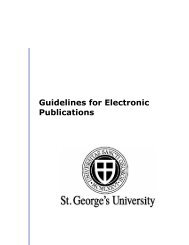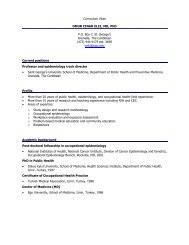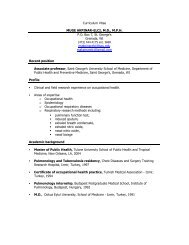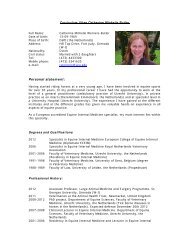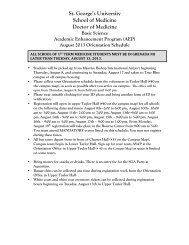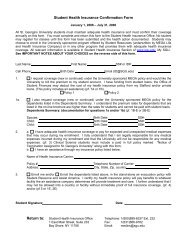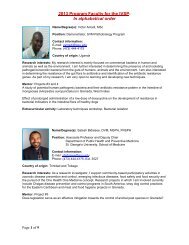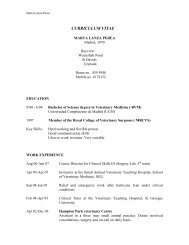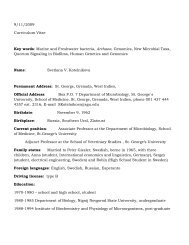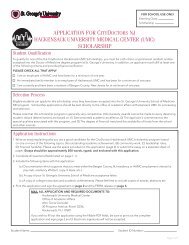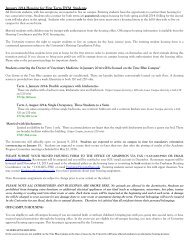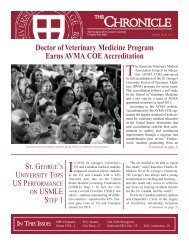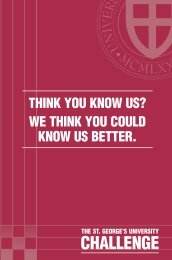SCHOOL OF 2012-2013 - St. George's University
SCHOOL OF 2012-2013 - St. George's University
SCHOOL OF 2012-2013 - St. George's University
Create successful ePaper yourself
Turn your PDF publications into a flip-book with our unique Google optimized e-Paper software.
School of Medicine<br />
Course Descriptions<br />
of damage to the nervous system as seen in general<br />
clinical medicine and in specialties such as Neurology,<br />
Neurosurgery, Psychiatry and Ophthalmology and clinical<br />
correlations complement the basic science components<br />
of every course section. The course further aims to<br />
facilitate the development of professional competencies,<br />
which include clinical reasoning, components of practical<br />
clinical skills used in neurological examinations, basic<br />
interpretation of modern imaging techniques, and teambased<br />
inter-personal skills, in particular through small<br />
group practical sessions and interactive settings.<br />
• Buzz Group Discussions of Clinical Cases<br />
Buzz group discussions of clinical cases facilitate the<br />
application of clinically relevant knowledge gained<br />
during the preceding lectures. Participation in the case<br />
discussions will enable students to develop their skills in<br />
critical clinical thinking and reasoning. The discussions<br />
are guided by faculty, while the class will split up into<br />
small groups of 3 to 5 students each to discuss history and<br />
examination, and to rationalize the diagnosis.<br />
• Small Group Practical Sessions<br />
Small group practical sessions of no more than six<br />
students per group are targeted toward facilitating<br />
the awareness and development of professional<br />
competencies, which include clinical reasoning,<br />
components of practical clinical skills used in neurological<br />
examinations, basic interpretation of modern imaging<br />
techniques, and team-based interpersonal skills.<br />
Hands-on small group sessions on structure and<br />
function before midterm help students to match the<br />
three-dimensional structures of the central nervous<br />
system with sections produced by modern imaging<br />
techniques, such as CT scans and MRIs. After the<br />
midterm, students are taking their first steps to perform<br />
neurological examinations, while reviewing the underlying<br />
mechanisms and discussing the expected outcomes under<br />
physiological and pathological conditions.<br />
Each of the small group sessions includes a clinical case<br />
discussion related to the core material presented in these<br />
sessions.<br />
• Online Activities<br />
The Neuroscience course website contains essential<br />
course information, including lecture and small group<br />
materials, announcements, calendar entries, gradebook,<br />
and online activities. This allows students to review online<br />
presentations for difficult concepts, study supplemental<br />
material, complete online assignments or assessments,<br />
take practice quizzes and communicate with faculty and<br />
peers in discussion forums.<br />
PHYS 560<br />
Physiology<br />
The aim of this course is to provide students with a clear<br />
understanding of the most important concepts and<br />
principles of medical physiology. The lectures provide the<br />
information base while the laboratories and case studies<br />
provide the student with an opportunity to assimilate and<br />
integrate the material within a small group setting. The<br />
first half covers cardiovascular, cellular, muscle physiology,<br />
and an introduction to pharmacology. The second half<br />
covers gastrointestinal, renal, pulmonary, and endocrine<br />
physiology. Appropriate clinical perspectives are presented<br />
throughout the course. Review sessions are scheduled on a<br />
regular basis.<br />
• Laboratory<br />
Two human laboratory exercises pertaining to<br />
cardiovascular and respiratory physiology are included in<br />
the course. In addition, computer-assisted applications<br />
are used to present real clinical cases. These cases are the<br />
latest in multimedia presentation and include historical<br />
clinical data, clinical imaging e.g. MRI and X-ray, and<br />
patient interviews from real patient cases. For each of the<br />
laboratories, students work in groups of five to six; groups<br />
are assisted by a faculty member.<br />
• Clinical Case <strong>St</strong>udies<br />
Six clinical case studies pertaining to pharmacology,<br />
autonomic function, cardiovascular, respiratory, renal, and<br />
acid-base regulation are included in the course. For this<br />
portion of the program, classes are broken up into small<br />
discussion groups of five to six students.<br />
Public Health and Preventive Medicine<br />
Omur Cinar Elci, MD, PhD, FRSPH, Chair<br />
PUBH 501<br />
Topics in Community and Preventive Medicine:<br />
Medicine in Society II<br />
This course focuses on disease prevention, health<br />
promotion, and population health, as well as on the<br />
64 | <strong>St</strong>. George’s <strong>University</strong>



